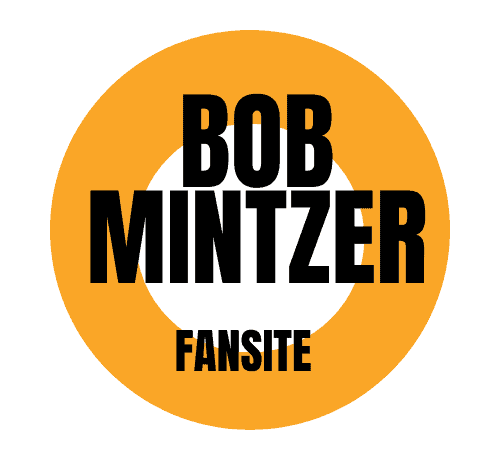BEST SELLER
In Stock
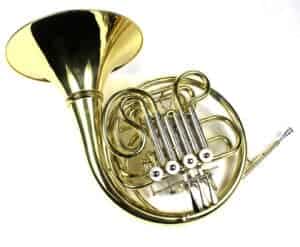
Monel Rotors Bb/F_
- Flawless Gold Lacquer Finish
- Key of Bb/F Bore Size .469 inch and detachable Bell Dia: 12.244inch
- Easy to Carry Detachable Bell, Balanced Weight Design
- Durable Light Weight ABS Case
- 4 durable Monel Smooth Rotors, Speedy and smooth rotary response
OUR CHOOSE
In Stock
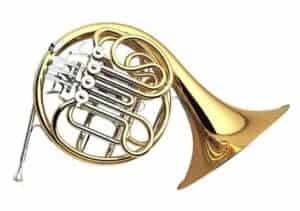
Yamaha YHR 567
- Hand orientation: ambidextrous
- Dimensions of the Package: 1.0 H x 1.0 L x 1.0 inches
- Package Weight: 21.0 pounds
- Country of Origin: China
The most effective French horn is a favorite instrument used for a range of musical styles, especially orchestras and symphonic ensembles. It is highly regarded because of its quiet, less abrasive sound, and also is distinguished by its large voice when paired in conjunction with other instruments.
Selecting the most suitable French Horn can be confusing in the absence of the correct information, particularly given the variety of available options.
We have compiled a concise list based on the most highly-rated French horns that are available for purchase. We’ve added a guide to buying that will provide all the essential aspects you must consider when purchasing a single French Horn.
Let’s get started!
Monel Rotors Bb/F_
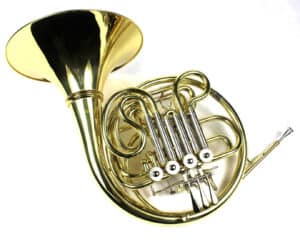
With a price that is extremely affordable, the Monel Rotors is one of the best French horns for anyone who wants to try their hand on this single French Horn before making the large investment that the majority of Horns require. As a product from a new manufacturer, you’ll take a huge risk regarding the quality. However, the manufacturer offers refunds within up to 30 days. Therefore, it is recommended to get the Horn checked by a certified technician before you decide to purchase it.
It’s a good thing that this French horn produces pleasant tones and has a detachable bell, which makes transportation and storage simpler. If the mechanisms of the instrument do not fail and you don’t have any issues, you can be left with a French horn that lets you progress rapidly as a beginner. A gold-lacquered finish can make the Moz visually attractive and also keep the hands from becoming green due to the yellow brass.
If you are looking for double French Horns, any price less than $3,000 could be considered a risk. Despite Moz rivals, we found it to be among the top high-quality French horns. Also, customer satisfaction is higher on Moz than many of the comparables at rock bottom.
Features:
- Flawless Gold Lacquer Finish
- Key of Bb/F Bore Size .469 inch and detachable Bell Dia: 12.244inch
- Easy to Carry Detachable Bell, Balanced Weight Design
- Durable Light Weight ABS Case
- 4 durable Monel Smooth Rotors, Speedy and smooth rotary response
Yamaha YHR 567
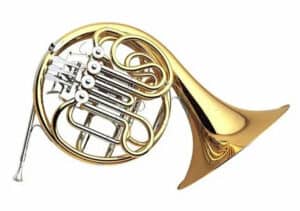
Reliability, quality, and long lasting are standard features of Yamaha instruments. The YHR567 isn’t an exception and this horn is one of the best French horns for anyone who is just beginning to learn. A high-quality instrument, such as this one, can help make learning simpler and more enjoyable for novices. The YHR567 is close to the standard for a reliable French Horn, the YHR567 is quite affordable when compared to other Horns.
A brass bell provides this French horn with a clear and bright sound and the corrosion-resistant nickel-silver slides with a smooth lacquer finish to increase its lifespan and toughness. Its fourth rotor (thumb lever) is adjustable, which makes playing comfortably for people of all hand sizes – both youngsters and adults. With its fast attack, superb response, safe high register and impressive projection the horn YHR567 is impressive and ideal for large and small groups.
The instrument can take students who are just beginning their studies up to the semi-professional stage. Professionals may require specific instruments that meet their needs regarding the tone and the details of the French Horn. In addition to a traditional mouthpiece and hard case, the beginner will be very happy using this instrument.
Features:
- Hand orientation: ambidextrous
- Dimensions of the Package: 1.0 H x 1.0 L x 1.0 inches
- Package Weight: 21.0 pounds
- Country of Origin: China
Jupiter Intermediate
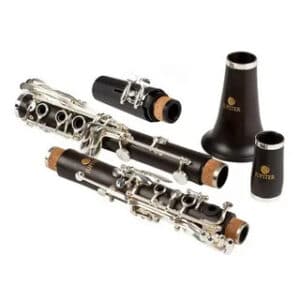
Jupiter has made a name for itself over the last few years with its consistent delivery of high-quality and reliable instruments. The JHR1100 model is an intermediate French horn designed specifically for intermediates and comes with a variety of professional features and for sure it’s one of the best instruments of this kind among others.
With a lacquered brass body and lead pipes made of rose brass, you can be assured that the JHR1100 produces an incredibly rich and full tone. The tapered rotary valves and open wrap provide an incredibly free-flowing and fluid playing experience. The body has been specifically designed to provide pitch precision and playing comfort. The JHR1100 has amazing volume and projection which makes it a great instrument to add to any band. It comes with an exclusive wooden carry case that is difficult to not be excited by this horn.
The JHR1100 can be used for getting students through their college education, and even to the professional stage. For some players, the disadvantage is that there’s not enough difference between their novice French horn and the one that is intermediate and therefore worth the money. A beginner with an instrument of good quality could be better off not bothering with the intermediate option and going straight to a professional horn in the event of a need.
Features:
- Lacquered Brass Body is produced with the most advanced technology to provide an instrument with the highest quality and playing ability
- Rose brass lead pipes warm the tone of the instrument, and also provide an increase in the longevity of your instrument
- Precision Mechanically-Linked Tapered Rotary Valve in combination with the open wrap design provides an open and fluid performance experience
- Double F/Bb
- Lacquered Brass Body
Holton H179

The decision between H179 as well as the later discussed 8DS was difficult, considering that both instruments are stunning masterpieces of design. Holton is another highly regarded and seasoned manufacturer of high-quality French horns. Their H179 model is among the most well-known among the Farkas series, and it is understandably so.
The H179 is a fixed-bell nickel-silver French horn that has tapered tubing as well as a broad bell, resulting in the darkest, heavy, and full tone. The solid nickel silver provides this horn with an extremely centered tone and a superb response. A.468 bore and tapered rotary valves provide an effortless playing experience. It also lowers the resistance of airflow.
Priced competitively with other professional nickel-silver best French horns, the H179 is an excellent value. The fixed bell could be a disadvantage for certain players. In addition to the standard models we’ve examined here in the present, more costly customized options are available. However, professional players are likely to be further ahead in their careers and have come up with specific designs for custom horns to be considered. In all normal applications, the H179 will exceed the expectations of players.
Features:
- Bore .468-inchBell: 12.25″ diameter
- Pitch A445 with independent Bb tuning
- Key: F Bb
Yamaha YHR-314II
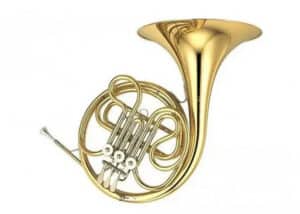
Although single-best French Horns are usually targeted at novices, a lot of intermediate players might like this instrument. With Yamaha’s 5-year limited warranty, you’ll be confident in the quality and longevity of this.
The best French horn is in F major. F the horn provides is an extremely rich sound for an instrument made of brass. The specialized wrap reduces airflow resistance and improves the level of comfort. The outer and inner slides have been upgraded to nickel-silver which makes them resistant to corrosion. For intermediate players, they will love the exact intonation that this horn provides particularly in the upper registers – it is possible to find inferior horns that lack this feature.
It is lighter and easier to use in comparison to a double French horn. The YRH-314II could be an ideal choice for a beginner who has displayed determination and already acquired some basic abilities. It comes with a 32C4 Yamaha mouthpiece, ABS carrying case, and accessories of the best French horn is a fantastic value and an investment that is worth it for the most skilled player.
Features:
- Mouthpiece taper developed for greater response and intonation. Wraps allow an easy hand position. Tough nickel silver slides, both inner and external. Tapered valves. Warm, rich sound. Lightweight ABS case
- It’s light and easier to use than a double French horn, which is ideal for students who are just beginning their horn studies.
- Single F Key
- The taper of the mouthpiece enhances tone and response, and the wrap offers an easier hand position and more fluid airflow
- Nickel silvered inner and outer slides provide more fitting and less risk of rusting than brass
Conn 14D
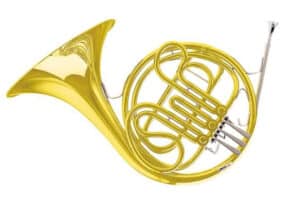
One of the top models from Conn – The 14D – comes with Conn’s top-quality guarantee and quality workmanship.
The 14D is brass with a yellow body with a transparent epoxy finish. The tapered valves work smoothly and effortlessly. The French horn is precise in its intonation and rapid response that you’d expect from a Conn Horn. Its balanced tone will be enjoyed by a lot of players. The .468 bore and a #2 Conn mouthpiece make this horn a breeze to play. The 12″ bell makes a powerful projection as well as a strong and affordable one.
The price is affordable for the double French Horn from reputable and well-known brands, however, it’s at the top of the range that we recommend considering one French Horn, as many players would prefer the flexibility of the double French horn when they grow.
The 14D is also equipped with a luxurious hard case to transport and store. With the price, this is an excellent purchase for anyone who appreciates the advantages of one French Horn.
Features:
- Key: F
- Body Material: Yellow Brass
- Bell Size: Small
- Bell Type: Fixed
- Bore Size: .468″
- Wrap Style: NA
- Lever Action: Mechanical
- Finish: Lacquer
- Mouthpiece: Farkas Medium Cup
Conn 8DS
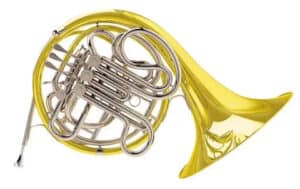
A slight modification to one of Conn 8D, a very loved double French Horn with professionals, the 8DS features all the standard characteristics of its sibling, the 8D. With it comes with a 12.25″ detachable bell and nickel-silver finish. It’s possible to expect top-quality craftsmanship from Conn and their horns maintain their value well over the years.
Nickel-silver French Horns typically have warmer, darker sounds as opposed to their brassy or brighter counterparts. The 8DS is no different. Its .468 bore was specifically designed to provide precision and control. The removable bell makes transportation and storing this French horn a lot more convenient than a fixed bell horn. If you don’t plan on traveling a lot using your instrument, the fixed bell Conn 8D might be the best choice, since there’s a substantial cost difference. It offers the great response that you would expect from a French horn of this quality and when paired with the fluid airflow, you’ll be able to enjoy this horn and be easy to use.
The 8DS has a fair cost for its top-of-the-line technology and features. However, it is a major investment. The players must be adamant about their instrument before deciding to purchase this French Horn.
Features:
- Bore: .468-inch,
- Bell: 12.25-inch
- Bell Type: Fixed
- Bell Throat: Large
- Key: F/Bb
Conn 11DS
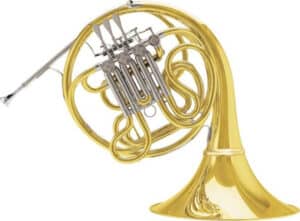
The recordings of Conn allow a player to create more vibrant sounds that fit a particular group of musicians as a group or an individual – however it is hard to be ignored by this amazing-sounding instrument.
The bell for the throat measures twelve inches in length and is a Geyer wrap. The bell weighs 18lbs with dimensions of 23″ x 15″ x 19″. Conn is among the best French horn brands available and they have carved their place in the wind instrumentation too.
If you are a soloist and would like to find the perfect instrument that has brighter tones? This is your ideal choice. Since Conn has set the standard through the Orchestra series, you’ll be in good hands whether you are a beginner or an advanced student.
The 11D features a Geyer wrap and throat bell that measures twelve inches in length. This is believed to be a leap above its predecessor, the 10D. It’s robust and should be suggested for beginners who are in their goal of learning French Horns.
Features:
- 11DS Symphony Series: Screw Bell, Double French Horn, Lacquer Screw, Rose Brass Bell
- 11D Symphony Series offers the player a more vibrant sounding instrument, which is perfect for soloists or section players who need to stand out from the rest of the group.
- 11D Series features a Geyer style wrap as well as a 12-inch medium throat bell to provide a rapid, bright response, which is more spacious than a 10D Horn.
- 11D Symphony Series offers the player a louder and more pronounced instrument, which is perfect for section players or soloists who want to stand out from the other players in the ensemble.
Types of French Horns
There are three basic types of French horns: single, double and triple French horns. Single horns are the most commonly used kind. A descant horn is a distinct type of triple horn, which is discussed in more detail further in this article. Each has its own characteristics and uses.
1. Single Horns

There are a variety of different kinds of French horns that are available. The most basic (and most affordable) can be described as a single French Horn, which is operated by three rotors, and is available with two key options: Bb and F. Single French Horns are the preferred option for students in the early stages because of their lower price, weight reduction, and the ease of use these instruments offer.
1.1. F Horns
It’s the most popular model of the single horn category. Due to its lower slide of tuning to tune purposes, it has a traditional natural horn tone that is pronounced in the lower and mid regions. The F horn comes in two sizes: Standard and Deluxe. The latter is the sought-after option for beginning students throughout the United States because of its small size, simple gameplay and its low price.
In certain performances, using F Horns is acceptable for professional and intermediate musicians, but they may find them restricted because they do not play well in higher frequencies.
1.2. Bb Horns
The first remedies to F Horn shortcomings in higher ranges comprised changing the French Horn to a higher tune and using it within the upper frequency. In the process, the Bb horn was born to be. A few skilled French horn players opt for the Bb horn to play in particular compositions due to its superior reaction and accuracy in the high ranges, as well as its lightweight when compared to other Horns.
When it comes to being an instrument of primary use, the Bb horn certainly is such, but it has certain limitations. It has a less-than-perfect tone in the lower and mid-ranges and is unable to play all notes in the lower register, for instance.
2. Double Horn
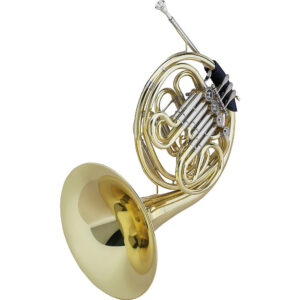
Double french horns were designed to address the issues caused by single horns as well as to increase the responsiveness of the French Horn. A double French horn is capable of transferring between keys F and Bb using the fourth rotor thanks to the genius that is tubular engineering. The rotor controlled by the lever on the left removes about the equivalent of 4 feet of tubing that is dangling from the air column inside the horn.
French horns may also be modified to ensure that the lever works reversely, turning the horn into an F instrument once it is engaged.
Double horns are extremely popular as the primary instrument of professional and intermediate performers because of their flexibility. But, depending on the degree of dedication toward the instrument, high cost and weight could be a disadvantage for students in the early stages of their education.
When choosing the best French horn, a key factor is the wrap of the instrument or how the tubing is wrapped. A double horn is wrapped in two ways. If the horn is in use and the Kruspe wrap raises the fourth rotor above the three other rotors, in turn, the linkage between the lever which controls the fourth valve as well as the actual valve gets shorter.
It is the Geyer wrap (called in honor of its German designer, just like Kruspe wrap) that puts the fourth wheel on top of the third, the linkage is significantly longer as it extends beyond the other three rotors.
Single F Horns are an ideal model for beginners. A double horn is usually used by professional and intermediate musicians. Both tiers are constructed with superior quality and top-quality materials. Professional models often have sophisticated workmanship to give the most beautiful clarity and tone.
Even though these models cost more than one-piece horns, a few students might discover that a double French horn is a better long-term investment, which they will continue to make use of as their skills increase.
3. Triple Horns
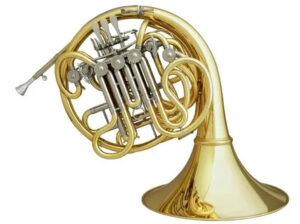
The double French Horn effectively integrates two F the Bb and F horn to create one instrument The triple horn is an additional instrument: the alto F Horn. Triple horns are becoming a sought-after alternative, especially among professional musicians because of their better performance in the higher ranges.
Some might consider the instrument’s weight as well as its higher cost to be major drawbacks. Check out through the Musician’s Friend assortment of triple French Horns to find an instrument that can handle all ranges with ease.
If you are a beginner, you might be looking for an instrument with more stability in the upper registers, and less attention to middle and lower registers. In this case, the descant horn — which is an instrument that is doubled and blends the Bb and the alto F horns–is a possible alternative. Descant horns, lighter in weight and less expensive than triple horns are preferred by some players for playing music that emphasizes the horn’s larger range.
Buying Guide for the Best French Horns
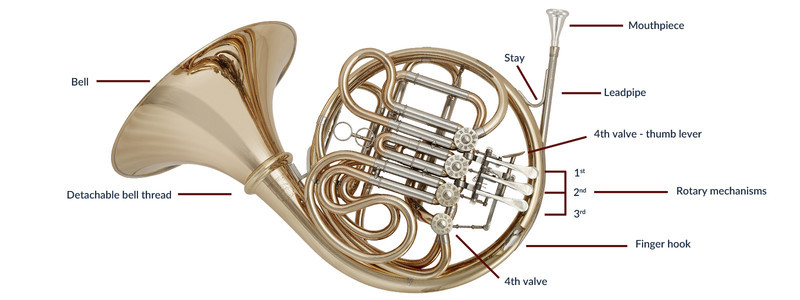
A French horn is an enormous financial investment. The first step in purchasing the most suitable French horns is to determine the (realistic) spending budget on the brand new French horn. The cost of a double horn can range between $200 and $18,000, which is why setting a budget is crucial in narrowing your choices.
If you’re looking for a brand new double horn, it is recommended to set the budget at $3500 (more desirable) as any less than that is likely to be produced using inadequate quality control. The valves often don’t fit, the slides are smashed, the solder joints are poorly made, besides, the French horn tapering components are likely clogged up on these horns at a low price. Repairing just the valves on these horns could be more expensive than the instrument itself.
There are many things to think about before buying a French horn; however, here are some of the most important.
Wrap
Kruspe, as well as Geyer, are two of the more commonly used French wrappings of the horns. Kruspe wrap horns come with a change valve that is located closer to the “front” of the French horn (closer to the player). However, Geyer wraps French horns including the valve to change that “back” of the French horn (away from the person). There are many opinions regarding the effect of this but here are a few general remarks:
Although it is not always the case, Kruspe wrap horns are typically nickel silver-colored and have larger bell throats that produce more pronounced sounds.
Geyer wrap horns are usually (but they are not necessarily) composed of yellow brass with bell throats of medium size, making a loud sound.
Material
In general, there are three kinds of materials that are used by horn makers to create French horns. Rose, gold, yellow brass (or red or gold) brass, nickel-silver are the three most commonly used metals and rods of metal used in the production of most horns.
I. Yellow Brass
It is most likely the most popular material used that is used to create French horns. It produces an average dark tone, but it is capable of producing more vibrant sounds when pushed. It’s also in the middle in terms of quality compared to other instruments that make use of other materials.
II. Rose Brass
It is considered to be a softer product than yellow brass. it is also the material used to make the bells made of rose brass. Therefore, you must be careful when handling it to avoid dents and dings. As compared to brass with a yellow color, which has a more pronounced tone, there’s less flexibility in tone offered by this instrument.
III. Nickel Silver
Contrary to silver-plated horns, nickel silver instruments don’t have any silver plating – they are made entirely from a different alloy. It is not made of silver, but it’s nickel what gives the color. Since it is a robust material, it can be used to construct premium instruments that are smaller than standard. Nickel silver horns make an extremely clear sound due to their very nature. They are typically employed in conjunction with larger bell throats.
Bell/Bore Size
When discussing their instruments, many manufacturers use terms such as “medium bore” and “medium bell” to describe their instruments. In the majority of cases, they refer to the dimensions of the bell’s neck.
In general, the bore (which is the tubing that runs through the center of an instrument made of brass) can range between 0.468 to 0.472 inches for the majority of French bells. The diameter of bells is typically around 12 inches in circumference. French horns with a larger bell neck are more likely to emit warmer tones. Contrary to this, instruments with medium and small bell throats create louder and more intense tones.
Fixed or Detachable Bell

It is mostly a matter of personal preference, ease of use as well as financial restrictions. The option of detachable bells is a wonderful option for those who frequently travel with their French horns (especially on flights). But, they can increase the cost of buying the instrument by a few hundreds of dollars. Bell ringing also adds an amount of extra weight for the French horn, which could be a challenge for some to handle.
Although there’s probably some difference in the sound and play between a fixed and a detachable bell, opinions on which is preferred are quite divergent.
Lacquered or Unlacquered
It is not possible to say that lacquer does not affect the sound. With a thickness on the inside and outside of 0.02 mm, this plastic-like covering accounts for approx. 10 % of the total material. Unlacquered sounds a bit more centered, which some people find brighter, some darker, some smoother and some harder. The lacquer might dampen the high overtones, and also add the extraneous noise in the sound, causing the horn to sound clearer, for some brighter, although it is acoustically darker. Allegedly the difference is minimal and 50 % of hornplayers sound better on a lacquered instrument. The lacquer is more resistant to sweat than the metal and the horn will last longer if it is carefully polished when it is relacquered. It also prevents your hands from turning green. A shiny horn also makes a better impression on the audience. Generally speaking, the advantages of a lacquered horn clearly outweigh the disadvantages. The combination screw bell/lacquered sounds good, perhaps even better. It is definitely not important for a hornplayer´s tone. The deciding factor is the players concept of sound.
(под этим заголовком текст полностью дублировался с предыдущим абзацем. Чтобы содержание текста соответствовало заголовку, была взята информация с англоязычного музыкального форума, посвященного духовым инструментам).
French Horn Maintenance Tips
- Make use of a mouthpiece brush along with dish soap and warm water to wash your mouthpiece.
- Using your polishing cloth, completely clean the surface of your French horn.
- Apply oil to slides. Take them one by one with a soft cloth, then apply some slide grease, and then carefully put them back within your French Horn.
- The rotors must be oil-lubricated. The valve caps should be removed and then work the oil into the shaft bearing and pivot points by adjusting the valves.
- Clean the insides of your French horn each month to ensure it is well-maintained and in good condition.
- Take apart the French Horn (do not get in touch with the valves for the rotor which a trained professional must remove) in a large tub or basin that is filled with mild dish soap and warm water.
- Take care when handling dismantled components because even the tiniest scratch could prevent them from being able to fit back to your French horn and functioning correctly. Falls are covered by a soft, cushioned towel placed over the counter as well as at the end of the tub or sink.
- Rub through the tube interior with your snake for cleaning.
- Clean and thoroughly dry the components.
- Use a tiny amount of oil to the slides before installing them back into the French horn.
Final Thoughts
Our list was compiled using the most prestigious French reviews of horns and expert opinions of the best french horn brands. We’ve found a balance where this list includes the best of both! The list of people’s choices represents what experts have selected as the top features. We hope that you get the correct French horn on this list.
